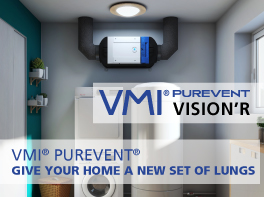FAQ
→ The consumption of a VMI® system varies depending on the climate (outdoor temperature), the volume of the home (positive input flow rate) and the selected preheat temperature (setpoint temperature). Blown air can enter the home at a temperature of 12°C, 15°C or 18°C, as preferred. Consumption includes ventilation as well as the preheating of the fresh air.
→ The VMI system blows filtered air (protection against outdoor pollution, pollen, fine particles), can be used to ensure comprehensive air flow throughout the home, treating humidity problems (mould, dust mites), and removes indoor pollutants (CO², VOCs, radon). On this basis, the VMI system can be used to ensure good indoor air quality, protecting your health, as well as your home.
→ The VMI system blows filtered air (protection against outdoor pollution, pollen, fine particles), can be used to ensure comprehensive air flow throughout the home, treating humidity problems (mould, dust mites), and removes indoor pollutants (CO², VOCs, radon). On this basis, the VMI system can be used to ensure good indoor air quality, protecting your health, as well as your home.
→ Thanks to the VMI system, you can protect the occupants of the building from the different sources of allergens. In fact, thanks to the effective filtering of the outdoor air (Grade F7 filter), the main allergens carried by the outdoor air do not enter the home. Thanks to the positive pressure generated by the positive ventilation, the air is swept through all the rooms, removes indoor pollutants (CO2, VOCs, etc.) and limits the development of dust mites and mould due to dampness.
→ We currently have VMI® systems, which have been well maintained and are still operating 20 years later.
→ Filter clogging must be checked at least once every 6 months and the filter must be changed at least once a year.Filter clogging will vary depending on the outdoor pollution in the location (e.g. urban area or countryside).
→ The system comes with a 5-year manufacturer warranty for parts and labour (subject to maintenance conditions).
→ An air vent is required in each room. External trickle vents can be used.→ Check that the internal doors (regulatory requirement for all ventilation systems) have been duly calibrated (for healthy air flow).
→ The VMI® system blows in fresh air, filtered and preheated, at a high point, and pushes the heat stored at the ceiling to the living environment. Positive ventilation creates a slight positive pressure in the home, ensuring incoming fresh air, treating condensation problems and fighting pollutants: CO², VOCs, gas buildup, particularly radon. The VMI system will not imply any risk of a malfunction for combustion devices. A mechanical ventilation system sucks the stale air into damp rooms and creates negative pressure in the home.
→ Excessive humidity represents the main source of pathologies (allergies, asthma, bronchitis, etc.) alongside of mould and the development of dust mites. Humidity in the home is therefore harmful for the health of occupants, but also for the long-term condition of the building.
→ For your comfort: to ensure that the air entering your home during cold periods is not at outdoor temperature.
→ The VMI® system is equipped with 2 electrical resistors – Max. power 540 W each – which can be used to ensure positive fresh air input at a selected temperature (12°C, 15°C or 18°C), reducing the effort required by the home heating system.
→ No, the VMI system generates noise representing between 28 db and 52 db, depending on the selected speed (decibels measured at a distance of 1 m in an anechoic chamber, according to the DIN 45635 standard).
→ Up to 320 m² (for premises with a constant floor-to-ceiling height of 2.5 m). This point depends on the selected range and the housing.
→ Little work is required, making the set-up low-cost, with a compact design, cheap and simple maintenance (no need to call on the services of a professional, no contamination of the fresh air duct network with various dusts and pollutants), low noise levels, effective and controlled fresh air input, and reduced radon air pollution.
→ 2 or less, it all depends on the shape and/or volume of your home.
→ Ensuring incoming fresh air thanks to a slight positive pressure obliges the air to reach the furthest corners of your home and therefore ensures that 100% of the volume is treated. The VMI® system ensures a constant flow of fresh air.
→ With a positive input system, the flow of fresh air entering a home is controlled and stale air is discharged outside.A positive input system is used in surgical rooms, IT clean rooms, cars, etc.
→ The VMI® system, thanks to positive pressure, blocks the build-up of radon, which radiates from the ground, unlike a mechanical ventilation system, which sucks in air and creates a negative pressure in the home.
→ In France, at Saint-Herblain, in the Nantes region.
→ Depending on the versions, VMI® systems can be fitted in Cube, Compact, Galbé or Maxi housings











